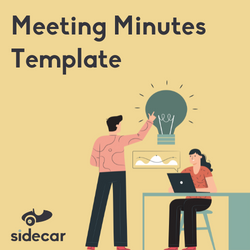In the U.S., people attend approximately 11 million meetings a day, with the average person spending three hours a week on meetings (and nearly a third spend five hours or more). While some meetings are critical, generative spaces where everyone leaves motivated and validated, most — about 71% — are unproductive and a waste of time. These unproductive meetings cost organizations a whopping $37 billion a year in lost productivity.
Don’t let your association fall into the trap of a bad meeting. Here are 14 ways to make meetings better.
What Makes a Meeting Bad?
We’ve all been in bad meetings. There are many different things that make meetings bad, including:
- A topic that doesn't pertain to you
- A boring speaker/presentation
- Poor organization
- No clear agenda
- A meeting that is too long
- No follow up
In short, bad meetings offer no value for participants and may actually lead to resentment and poor performance.
10 Ways to Make Meetings Better
Before you throw in the towel on meetings, here are 14 ways to make them better.
1. Determine if it’s necessary
Everyone has spent time in a meeting that could've been an email. Make sure your meeting actually needs to be in person (or via Zoom).
2. Send out the agenda ahead of time
This sets expectations and outlines what the meeting’s goals are. It also lets attendees know that you are focused and have a purpose for scheduling a meeting.
3. Be selective in who you invite
Does every person from every department actually need to be there? Restrict the meeting invitation to people who will actually benefit (or who need the information for later use or decision-making).
Jeff Bezos calls this the “two pizza rule.” If you need more than two pizzas to feed everyone in the room, the meeting is too large.
4. Consider the physical space
The physical space of the meeting encompasses the size of the room, its temperature, the ambient noise level, and the chairs and tables available. Don’t try to shove people into uncomfortable chairs in a too-small room that is loud and distracting. That’s a recipe for disaster.
5. Arrive prepared
If you need charts, graphs, pens, technology, or anything else, make sure you have it with you. Stopping to retrieve something you forgot is a waste of everyone’s time.
6. Encourage (but don’t require) participation
The average meeting attention span is approximately 15 minutes, but that number gets slashed in half if you’re just lecturing. Keep attendees engaged by asking questions and getting people talking.
But keep this in mind: some people prefer to process information quietly and may not want to chat about it. This is a legitimate work style, so don’t force participation.
7. Redirect negative chatter
Depending on the meeting’s agenda, it can be easy to slide into complaining or negativity. While there should be space for working through legitimate concerns, this type of talk is not necessarily productive in a larger meeting.
Redirect comments that spiral into negativity or stray too far off track. Make sure to follow up on any issues that were brought up during the meeting — the goal is not to silence anyone’s concerns but to address them at a more appropriate time.
8. End on time
Starting and ending on time is a concrete way to show meeting attendees that you value their time. There are some simple strategies to ensure meetings end on time.
- Use a timer and stop when it goes off (regardless of where you are on the agenda).
- End the meeting when the work is done (don’t tack on additional items if you finish early).
- Let people leave if they need to.
Another way to keep meetings short and avoid going over time is to hold them while standing. This unorthodox strategy is best for meetings that are short to begin with and should only be implemented if all attendees are capable of standing.
9. Share the minutes
Without delay, share the meeting minutes. Highlight:
- A list of attendees
- Items for further discussion
- Any documents handed out or presentations shared
- Immediate action items
- Positive strides forward
- Growing edges (and how you’ll support them)
Avoid singling anyone out unless it is for positive notes, and end the minutes with the date and time of a follow-up meeting (if needed).

Meeting Minutes Template
Never have a bad meeting again! Download our meeting minutes templates.
Download Now
10. Get feedback
Ask for (and gracefully receive) feedback on the meeting itself. You might think the meeting was a marvel of productive efficiency, but the attendees might have another opinion. Positive or negative, feedback is the way we grow and become better at everything we do.
If feedback is negative and challenging to absorb, take a few days before reading it again. Consider your goals as a leader in general, and try to frame the feedback not as a personal issue but as an opportunity to make improvements professionally.
Improving Online Meetings
Some associations have embraced a post-COVID hybrid model, with meetings remaining online. Other associations with members across the globe have always met virtually. These gatherings can be improved, too.
1. Use the appropriate technology
Zoom is just one tool in the online meeting space. Use schedulers, note-taking software, and other tech to keep meetings engaging and on track.
2. Make sure the technology works
Few things are more frustrating in online meetings than technology that just won’t cooperate. Lag times and frozen screens will kill your meeting’s momentum like nothing else.
3. Limit comments during the meeting
If attendees are participating in deep discussions in the comment section, how do you know if they are getting the information that is being delivered? And while it’s nice to get positive feedback in the moment, even supportive comments can be distracting and take the focus off the meeting’s goals.
Limit commenting and questions during the meeting, but open them up for the last five to ten minutes.
4. Use a moderator or host
A moderator or host is an invaluable tool for making online meetings better. This designated person admits late attendees to the meeting, fields questions from participants, and organizes the questions and comments made during the meeting itself.
Designating a moderator is a great way to strike the balance between turning off comments completely while still allowing meeting attendees to comment and ask questions in real-time.
The Bottom Line
Everyone in your association will appreciate your efforts to improve meetings. With just these few simple tips, you won’t need to throw in the towel on a bad meeting ever again.
Tags:
Association Management
September 27, 2022


